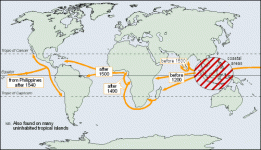Roadhse2
Sr. Member
- Joined
- Mar 15, 2015
- Messages
- 376
- Reaction score
- 366
- Golden Thread
- 0
- Primary Interest:
- All Treasure Hunting
Yes, the Templars did not originate trade or trade routes...
Ports that they visited could have had these fibers being used for packing over and over and moved around the world to ports further and further from the orignal source. Why you think the Templars would be the only ones to have access to it makes no sense to me. If the fibers were such a rare commodity then they would not be disposed of after one trip, but stored and reused as packing materials again and again...much the same way people now save bubble wrap or foam peanuts.
To hinge your Templar theory on the found fibers is very slim evidence of them visiting at all...the same could be said for any group. I'm not saying they didn't visit Oak Island, just that the fibers mean nothing in that regard.
It could mean 'someone' did visit Oak Island from 1300 forward, but 'who' is wide open...
Edit;
You have said the fibers do not degrade unless subjected to extremes...so the fibers found could have been used for a much longer time than the 1300 reference point, even Marco Polo needed packing material moving goods from South China to Europe during the 1200's via land and sea...Those same fibers would be reused to transport items again and again from one port or destination to the next...buying and selling them would also make a lucrative business wherever goods were warehoused, repacked for distribution to other destinations as needed. Simply tossing them out when they arrived would not be done as they were a commodity in themselves..
Ports that they visited could have had these fibers being used for packing over and over and moved around the world to ports further and further from the orignal source. Why you think the Templars would be the only ones to have access to it makes no sense to me. If the fibers were such a rare commodity then they would not be disposed of after one trip, but stored and reused as packing materials again and again...much the same way people now save bubble wrap or foam peanuts.
To hinge your Templar theory on the found fibers is very slim evidence of them visiting at all...the same could be said for any group. I'm not saying they didn't visit Oak Island, just that the fibers mean nothing in that regard.
It could mean 'someone' did visit Oak Island from 1300 forward, but 'who' is wide open...
Edit;
You have said the fibers do not degrade unless subjected to extremes...so the fibers found could have been used for a much longer time than the 1300 reference point, even Marco Polo needed packing material moving goods from South China to Europe during the 1200's via land and sea...Those same fibers would be reused to transport items again and again from one port or destination to the next...buying and selling them would also make a lucrative business wherever goods were warehoused, repacked for distribution to other destinations as needed. Simply tossing them out when they arrived would not be done as they were a commodity in themselves..
Amazon Forum Fav 👍
Last edited:





 That is not a fact that they came to Oak Island,
That is not a fact that they came to Oak Island, Still no facts of treasure of any kind being hidden on Oak Island.
Still no facts of treasure of any kind being hidden on Oak Island.

 I get your point on the distances involved. However - and this is a rather large however - if a fleet set out in late 1307, they picked a bad time of the year to do it. Have you ever been in the North Atlantic during the fall/early winter? There was a reason that the Norse sailed in the summer and wintered over if they couldn't make it back before the weather turned, as the trip across the Atlantic was dangerous enough with favorable weather. Templars may or may not have known about this, but any hired Norse help certainly would have.
I get your point on the distances involved. However - and this is a rather large however - if a fleet set out in late 1307, they picked a bad time of the year to do it. Have you ever been in the North Atlantic during the fall/early winter? There was a reason that the Norse sailed in the summer and wintered over if they couldn't make it back before the weather turned, as the trip across the Atlantic was dangerous enough with favorable weather. Templars may or may not have known about this, but any hired Norse help certainly would have.